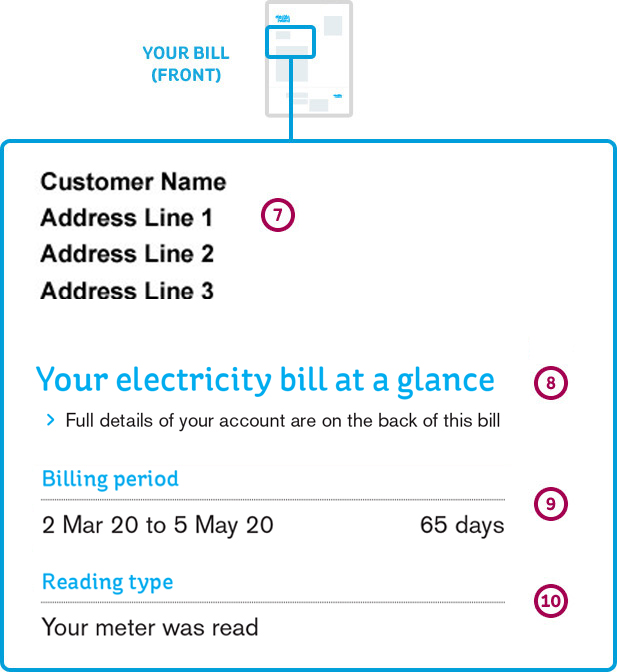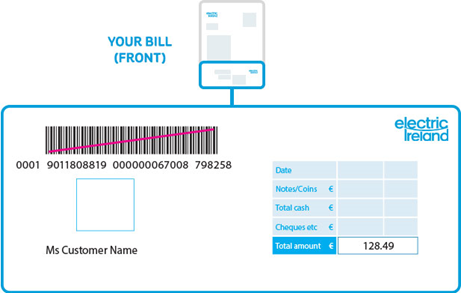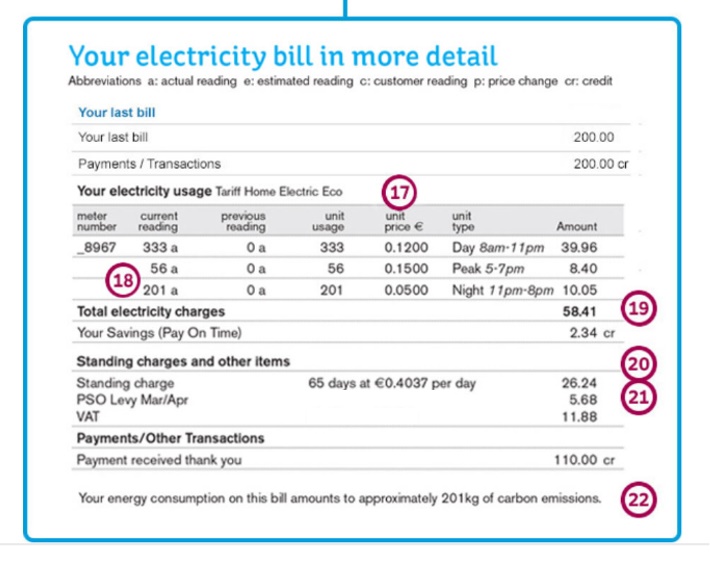Understanding your Electricity Bill
The Breakdown of your Bill
1. Your account number
2. To ask about this bill
Please contact us at 1800 372 372 with your account query.
Choose Option 1 and have your account number ready.
3. For emergencies or electricity Interruptions
To report an electricity interruption or emergency, please call ESB Networks on 1800 372 999 .
4. MPRN
Your MPRN (Meter Point Reference Number) identifies your connection to the ESB Network and it’s unique to your home. You’ll need to quote your MPRN if you call ESB Networks with a query.
5. These codes are on your bill, and this is what they mean:
DG number: Identifies your Distribution Use of System (DUoS) profile, it is a charge that Electric Ireland pays to maintain the electricity network - ESB Networks classifies Urban customers as DG1 and Rural customers as DG2.
MCC: MCC stands for Meter Configuration Code. It's a code that is used to describe the type of meter (or its functionality) you have. For example:
MCC01 – Standard 24-hour meter
MCC02 – Standard Day/Night meter
MCC03 – Standard 24-hour meter with Night Storage Heating
MCC12 – Smart meter - Half hour, this also means that you can view your
half-hourly usage information in your online account
MCC16 – Smart meter - Day Night Peak
Profile: Your profile is a code we use to predict your electricity usage.
6. Invoice Number
Each of your bills has its own date of issue and invoice number.
7. Your bill address
This is the postal address you registered with us.
8. This bill is for
An address will only be shown here on your bill if the postal address is different to the supply address.
9. Billing Period
This is the number of days you are being billed for and the dates when the electricity units were used.
10. Reading Type
If you have a standard meter,
you will see you will see one of these messages on your bill:
- We read your meter - an ESB Networks technician visited your home and read your meter
- We estimated your usage: An estimated reading based on our previous readings
- You read your meter: You supplied us with your meter readings.
If you have smart meter:
And your meter has a good level of connectivity, these messages will not appear because your meter readings will be automatically sent to the network operators and shared with us to calculate your bill.
What is meter connectivity?
Meter connectivity refers to ESB Networks’ ability to connect with your meter and obtain your electricity usage data. The higher the number of days your meter can be read remotely in a month, the higher your meter connectivity will be.
There may still be occasions when remote meter readings are not able to be captured which could result in an estimated bill.
How to read your smart meter
If you have:
High connectivity your connection can support Interval (30 minute) Smart Services or Non-Interval (Bi-Monthly) Smart Services (level 3 or 4)
Low connectivity your connection will only support non-interval services (level 1 or 2) and may still need to be read manually.
You can see which smart meter communication signal you have in your Electric Ireland online account. This is found in the tab named “details” when you choose your electricity account.
Should you wish to take a meter reading yourself, the process is simple. To read your meter you'll see your cumulative meter reading in kilowatt hours, or "kWh" on the main digital display screen. You don't need to press any buttons on the meter.
- Read the on-screen digits displayed before "kWh" from left to right, remembering to include all digits when reading.
If you wish to see your meter readings for night time, day time, peak time or your export of electricity, you will need to press the push button on your meter: - Display screen: Your cumulative meter reading
- Press one: Date & time screen
- Press two: Your cumulative meter reading
- Press three: 'Night' time meter reading. “A+” and “T1” will appear in the top right-hand corner
- Press four: 'Day' time reading. “A+” and “T2” will appear in the top right-hand corner
- Press five: 'Peak' time reading. “A+” and “T3” will appear in the top right-hand corner.
- Press six: Test screen display
- Press seven: This is the total active energy export register (Micro generation customers), and “A-“ will appear in the top right hand corner.
How to read your smart meter
How to read your Day/Night meter
.jpg?sfvrsn=111ca060_1)
11. Payments
This is a summary of all your payments and transactions since your last bill.
12. Balance Brought Forward
This is the total balance due from your previous bill(s).
13. Charges for this Period
The back of your bill will show you a full breakdown of these charges: unit rates, savings, tax and levies for this period.
14.Total Due
This is the total amount due to be paid. Payment options are listed on the back of your bill.
15. Pay By
Your bill must be paid in full by the payment date. 14 days credit is allowed for bills with no arrears. Bills with arrears are due immediately. If you pay by direct debit, the amount of your bill is automatically collected from your bank account 14 days after your bill is issued.

16. Remittance Advice
You should detach this and send in with non-direct debit payments or when making payments at the post office or bank.

17. Price Plans
This is the name of your electricity price plan. Our smart meter plans are named ‘Home Electric+’ and are available to all customers who have a smart meter installed with a connectivity level of 3 or 4.
Find out more about Smart Electricity Meters and our Smart Meter Price Plans
18. Usage
Your present and previous meter readings are shown. You may also see a letter beside each reading:
“a” actual reading
“e” estimated reading
“c” customer reading
“p” price change
this bill includes a price change
“cr” credit
you will see “cr” beside payments you made to us and beside any discounts on your bill.
If you have a Smart Meter:
ESB Networks will read your meter remotely.
If you are selecting a smart price plan for the first time: your meter will be reconfigured so that your supplier will receive a minimum of three-meter readings: Day/Night/Peak.
The frequency of these readings will depend on the smart price plan you selected and if you consented to Electric Ireland using your half hourly data.
Once your smart price plan is active and you have signed up to sharing half hourly data, Electric Ireland will no longer receive meter readings from ESB Networks but receive half hourly data instead. You will see this half hourly consumption data on your electricity bills.
19. Total electricity charges
Here you will find the total number of units used in your billing period multiplied by the price per unit.
You will also see your savings, credits and a description and value of any discount you are receiving here.
20. Standing Charge
The standing charge is a fixed daily cost on your bill no matter how much electricity you use in your home. It is a combination of the fixed charges associated with providing and maintaining the supply of electricity to your home, the collection of meter readings and a share of the supplier costs in servicing your account.
21. PSO Levy
The Public Service Obligation Levy (PSO) is mandated by the Government and approved by the European Commission. It supports the generation of electricity from sustainable, renewable and indigenous sources. The levy is calculated and certified annually by the Commission for Regulation of Utilities (CRU). This calculation is done in line with relevant legislation. All energy suppliers are required to collect this levy from customers.
Here you will see the amount of kilograms of CO2 produced as a result of your electricity usage for this billing period.
Electricity Pay As You Go customers
If you are a Pay As You Go Electricity customer, you can view our Guide to Electricity PAYG statement.Why does electricity cost what it does
We have also created a helpful guide to give you a better understanding of what makes up the cost of your electricity.
